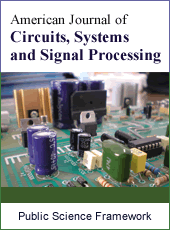American Journal of Circuits, Systems and Signal Processing
Articles Information
American Journal of Circuits, Systems and Signal Processing, Vol.2, No.1, Dec. 2016, Pub. Date: Nov. 2, 2016
The Implementation of Wiener Filtering Deconvolution Algorithm Based on the Pseudo-Random Sequence
Pages: 1-5 Views: 4688 Downloads: 3608
[01]
Zhen Xiao-dan, School of Information Engineering, China University of Geosciences (Beijing), Beijing, China.
[02]
Luo Xuan-chi-cheng, School of Information Engineering, China University of Geosciences (Beijing), Beijing, China.
[03]
Li Mei, School of Information Engineering, China University of Geosciences (Beijing), Beijing, China.
In order to get a better display in correlation identification, there are two types of deconvolution algorithms applied in correlation identification theory, which includes traditional frequency domain deconvolution algorithm and Wiener filtering deconvolution algorithm. This article derived the derivation of Wiener filter deconvolution and solved the zero problem traditional frequency domain deconvolution problem, and gave out the frequency domain expression of the system impulse response of the Wiener deconvolution filter. Then, after the comparison of the two deconvolution algorithms, it was shown that the identification results of the Wiener filter deconvolution algorithm were better than traditional frequency domain deconvolution algorithm when using the m-sequence as the system’s input signal. Finally, the Wiener filtering deconvolution algorithm was applied into correlation identification theory and achieved good identification results.
Correlation Identification, M-Sequences, Traditional Frequency Domain Deconvolution Algorithm, Wiener Filtering Deconvolution Algorithm
[01]
Lou Ping-an, Miao Chang, “Deconvolution Theorem”. Nuclear Electronics & Detection Technology, vol. 9, No. 6, pp. 454-459, 1999.
[02]
Shu Qing, Zhang You-zheng, “The DFT Algorithms of Deconvolution for X(k) Having Zeros”, Acta Electronica Sinica, vol. 18, No. 3, pp. 83-89, 1990.
[03]
Guo Jian-zhong, Chen Sen-Lin, “A Modified Means to Wiener Inverse Filter for Improving Vertical Resolution of Ultrasonic Signals”, Journal of Shanxi Normal University (Natural Science Edition), vol. 32, No. 2, pp. 40-42, 2004.
[04]
Deng Zi-li, Zhang Li-bo, “White Noise Wiener Deconvolution Filters”, Control and Decision, vol. 16, No. 4, pp. 488-490, 2001.
[05]
Li Mei, “Research of Time-Domain Spectrum IP Based on Correlation Identification Technology”, pp. 21-32, 2010.
[06]
Fan Chang-xin, Communication Theory [M]. Beijing: National Defend Industry Press, pp. 376-389, 2001.
[07]
Chen Xiaoxin, Qian Yong, “Study of UHF Partial Discharge Sensor Time Domain Parameters Based on Frequency Domain Deconvolution”, High Voltage Engineering, Vol. 41, No. 5, pp. 1488-1494, 2015
[08]
Zou An, “A Stimulus-sequence Optimization Technique and Deconvolution Method for Auditory Evoked Potentials, pp. 28-34
[09]
Zeng Xiao-ling, “Deconvolution and Deconvolution Algorithm”, Journal of Electronic Measurement and Instrument, vol. 3, No. 4, pp. 25-33, 1989
[10]
Liu Ming-ling, Cai Yong-quan, Rao Min and Liu Di, “Deconvolution Via Convolution Operation”, Acta Electronica Sinica, vol. 28, No. 5, pp. 111-112, 2000.
[11]
Rong Qing, Xiao Han, “Study on MMSM Wiener filtering-based speech enhancement method and its Matlab implementation”, Computer Applications and Software, vol. 32, No. 1, pp. 153-157, 2015
[12]
Ding Yumei, Kuo Yonghong, Digital Signal Processing - Time Domain Discrete Random Signal Processing [M]. Beijing: National Defend Industry Press, pp. 30-33, 2002
[13]
Lin Hui, Miao Yongmei, “Research on Wiener Filtering De-noising Algorithm”, Value Engineering, pp. 180, 2012
[14]
Yuan Lanjing, “Application of wavelet transform in Signal Denoise”, pp. 5-7, 2008.
[15]
Shu Qing, Zhang You-zheng, “Rediscuss the DFT Algorithms of Deconvolution for X(k) Having Zeros”, Acta Electronica Sinica, vol. 20, No. 12, pp. 79-81, 1992.
[16]
Zheng Rong, “Deconvolution Caculation of Signal Processing”, Signal Processing, vol. 11, No. 2, pp. 82-87, 1995.
[17]
Guo Jian-zhong, Lin Shu-Yu, “A Modified Wiener Inverse Filter for Deconvolution in Ultrasonic Detection”, Applied Acoustics, vol. 24, No. 2, pp. 97-102, 2005.

ISSN Print: 2381-7194
ISSN Online: 2381-7208
Current Issue:
Vol. 6, Issue 1, March Submit a Manuscript Join Editorial Board Join Reviewer Team
ISSN Online: 2381-7208
Current Issue:
Vol. 6, Issue 1, March Submit a Manuscript Join Editorial Board Join Reviewer Team
| About This Journal |
| All Issues |
| Open Access |
| Indexing |
| Payment Information |
| Author Guidelines |
| Review Process |
| Publication Ethics |
| Editorial Board |
| Peer Reviewers |


